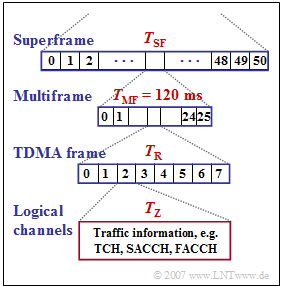Difference between revisions of "Aufgaben:Exercise 3.3: GSM Frame Structure"
| Line 36: | Line 36: | ||
<quiz display=simple> | <quiz display=simple> | ||
| − | {How long does a superframe last? | + | {How long does a superframe $\rm (SF)$ last? |
|type="{}"} | |type="{}"} | ||
$T_{\rm SF} \ = \ ${ 6.12 3% } $ \ \rm s$ | $T_{\rm SF} \ = \ ${ 6.12 3% } $ \ \rm s$ | ||
| − | {What is the duration of a TDMA frame? | + | {What is the duration of a TDMA frame $\rm (TF)$? |
|type="{}"} | |type="{}"} | ||
$T_{\rm TF} \ = \ ${ 4.615 3% } $ \ \rm ms$ | $T_{\rm TF} \ = \ ${ 4.615 3% } $ \ \rm ms$ | ||
| − | {How long does a | + | {How long does a burst last? |
|type="{}"} | |type="{}"} | ||
$ T_{\rm burst} \ = \ ${ 576.9 3% } $ \ \rm µ s$ | $ T_{\rm burst} \ = \ ${ 576.9 3% } $ \ \rm µ s$ | ||
| Line 50: | Line 50: | ||
{At what intervals $\Delta T_{\rm burst}$ is a user assigned timeslots? | {At what intervals $\Delta T_{\rm burst}$ is a user assigned timeslots? | ||
|type="{}"} | |type="{}"} | ||
| − | $\Delta T_{\rm | + | $\Delta T_{\rm burst} \ = \ ${ 4.615 3% } $ \ \rm ms$ |
{What is the bit duration? | {What is the bit duration? | ||
| Line 64: | Line 64: | ||
$R_{\rm Gross} \ = \ ${ 33.854 3% } $ \ \rm kbit/s$ | $R_{\rm Gross} \ = \ ${ 33.854 3% } $ \ \rm kbit/s$ | ||
| − | {What is the net data rate of | + | {What is the net data rate of one user? |
|type="{}"} | |type="{}"} | ||
$R_{\rm Netto} \ = \ ${ 22.8 3% } $ \ \rm kbtit/s$ | $R_{\rm Netto} \ = \ ${ 22.8 3% } $ \ \rm kbtit/s$ | ||
Revision as of 13:58, 11 January 2023
In the 2G cellular mobile communication standard $\rm GSM$ the following frame structure is specified:
- A superframe consists of $51$ multiframes and has duration $T_{\rm SF}$.
- Each multiframe has $26$ TDMA frames and lasts a total of $T_{\rm MF} = 120 \rm ms$.
- Each TDMA frame has duration $T_{\rm TF}$ and is a sequence of eight time slots with duration $T_{\rm burst}$.
- For example, in such a time slot, a "Normal Burst" with $156.25$ bits is transmitted.
- Of these, however, only $114$ are data bits. Further bits are needed for the so called "Guard Period" $\rm (GP)$, signaling, synchronization and channel estimation.
- Further, when calculating the net data rate, it must be taken into account that the logical channels SACCH and IDLE require a total of $1.9 \rm kbit/s$.
It should also be noted that, in addition to the described multiframe structure with $26$ TDMA frames, there are also multiframes with $51$ TDMA frames, but these are used almost exclusively for the transmission of signaling information.
Hints:
- This exercise belongs to the chapter "Radio Interface".
- Reference is made in particular to the sectione "GSM frame structure".
Questions
Solution
- $$T_{\rm SF} = 51 \cdot T_{\rm MF} \hspace{0.15cm} \underline {= 6.12\,{\rm s}}\hspace{0.05cm}.$$
(2) Each multiframe is divided into $26$ TDMA frames according to the specification. Therefore:
- $$T_{\rm R} = \frac{ T_{\rm MF}}{26} = \frac{ 120\,{\rm ms}}{26} \hspace{0.15cm} \underline {= 4.615\,{\rm ms}}\hspace{0.05cm}.$$
(3) A TDMA frame consists of $8$ time slots. Therefore
- $$T_{\rm Z} = \frac{ T_{\rm R}}{8} = \frac{ 4.615\,{\rm ms}}{8} \hspace{0.15cm} \underline {= 576.9\,{\rm µ s}}\hspace{0.05cm}.$$
(4) The spacing of time slots allocated for a user is.
- $$\Delta T_{\rm Z} = T_{\rm R} \underline{= 4.615 \ \rm ms}.$$
(5) Each burst consists - considering the guard period - of $156.25 \ \rm bits$, which must be transmitted within the time duration $T_{\rm Z} = 576.9 \ \rm \mu s$. This results in:
- $$T_{\rm B} = \frac{ T_{\rm Z}}{156.25} = \frac{ 576.9\,{\rm µ s}}{156.25} \hspace{0.15cm} \underline {= 3.69216\,{\rm µ s}}\hspace{0.05cm}.$$
(6) For example, the bit rate can be calculated as the reciprocal of the bit duration:
- $$R_{\rm B} = \frac{ 1}{T_{\rm B}} = \frac{ 1}{3.69216\,{\rm µ s}} \hspace{0.15cm} \underline {= 270.833\,{\rm kbit/s}}\hspace{0.05cm}.$$
(7) In each time slot, the data rate $R_{\rm B} \approx 271 \rm kbit/s$. However, since each user is assigned only one of eight time slots, the gross data rate of a user is
- $$R_{\rm gross} = \frac{ R_{\rm B}}{8} = \frac{ 270.833\,{\rm kbit/s}}{8} \hspace{0.15cm} \underline {= 33.854\,{\rm kbit/s}}\hspace{0.05cm}.$$
(8) For the net data rate, according to the specifications:
- $$R_{\rm Netto} = \frac{ 114}{156.25} \cdot R_{\rm Brutto} - 1.9\,{\rm kbit/s} \hspace{0.15cm} \underline {= 22.8\,{\rm kbit/s}}\hspace{0.05cm}.$$
